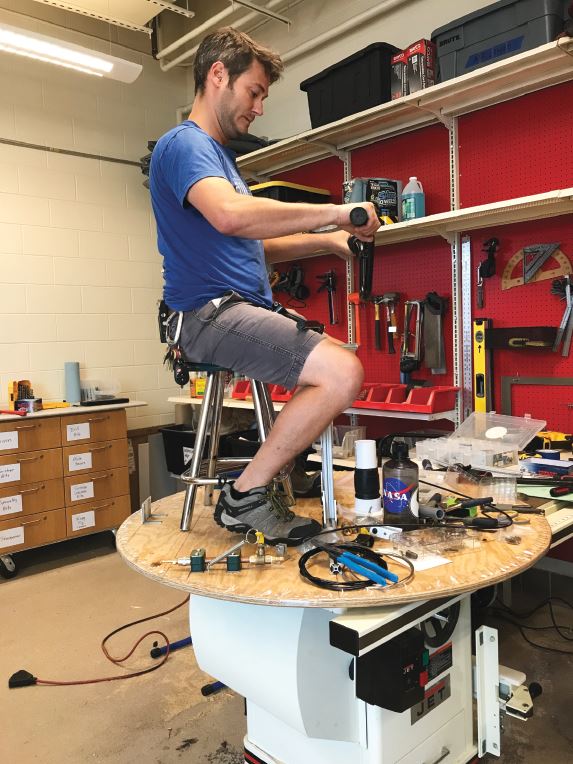How I Built a Hovercraft
Winter
2019
Building Blocks - Undergraduate Research and Outreach Projects
How I Built a Hovercraft
Bryan Gaither, Sigma Pi Sigma Member and Laboratory Manager, Austin Peay State University

I built this hovercraft to not only be an attention-grabbing demo, but also to promote our new engineering physics program. The hovercraft also marked the debut of the Fantasy Factory—a workshop where we build anything and everything awesome—at Austin Peay State University.
The main focus of this build is to demonstrate Newton’s laws of motion. I like to explain the hovercraft as a two-dimensional representation of docking a spacecraft to the International Space Station. With the cushion of air under the craft, there is no reference of friction to the ground. (And in fact, NASA uses a similar hovercraft in its “Astronaut Training Experience,” a tourist experience at Kennedy Space Center, to simulate the zero-friction environment of space.)
I built a very basic version of this hovercraft with my science teacher in the second grade. That craft was tethered by a corded leaf blower, so it couldn’t go very far. I have waited a long time for the battery technology to power a cordless leaf blower enough to lift me and 100 pounds of fire extinguishers.
For my Mark III version, I used plans from sciencebob.com1 as a reference but modified it slightly. The original plans call for a round plywood base over a tarp used as a bladder. A leaf blower inflates the bladder, giving a basic hovercraft, albeit one with no steering or brakes.
I used ¾-inch plywood for the 4-foot-diameter base, just as ScienceBob did, but swapped out 20-gauge clear vinyl from the craft store for the bladder. This allowed some flexibility in the bladder to handle uneven surfaces.
I also added steering, courtesy of two 20-pound CO2 fire extinguishers. These tanks have tubes that go to the base of the pressure vessel and force liquid CO2 through the nozzle. The liquid has the mass and a large enough expansion coefficient to provide a decent amount of momentum to the craft. The thruster assemblies are hard-mounted to the hovercraft base, and pressure washer quick-connects allow riders to change exhausted tanks quickly.
The default valves on the extinguishers limit the hovercraft to binary thrusting: fully on or fully off. I coupled a handlebar setup and brake cable assemblies from the local bike shop with compound bow cams from the local archery shop and attached them to ball valves to create variable thrust for propulsion. The cams give a 2:1 advantage, so a short pull of the brake lever translates to a longer travel in the cable, moving the ball valve from closed to wide open.
I used 80/20 extruded aluminum to build the central structure to mount the handlebars and safely secure the fire extinguishers.
I demoed the new version in front of a bunch of kids on campus for the Junior Govs Summer Camp. It was actually the first time I had tested the Mark III more than a few feet. The kids were really excited to see a “crazy mad scientist” in an Iron Man mask flying around the gym!
Of course, I’m not done. I already have a plan for the Mark IV.
I’d like to add a momentum curtain to provide a larger pocket of air under a larger skirt surrounding the hovercraft.
My goal is to start on land, navigate a boat ramp, and go full throttle down the river near campus. It is not a guarantee, but it sure is a dream of mine.
Reference:
1. https://sciencebob.com/build-a-hovercraft-you-can-ride/
More from this department
Building Blocks - Undergraduate Research and Outreach Projects
